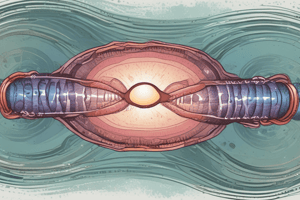Podcast
Questions and Answers
Explain how meiosis results in the transmission of chromosomes from one generation to the next.
Explain how meiosis results in the transmission of chromosomes from one generation to the next.
Meiosis ensures the formation of haploid gamete cells in sexually reproducing diploid organisms, resulting in daughter cells with half the number of chromosomes of the parent cell.
Identify the location where meiosis takes place and explain the importance of meiosis.
Identify the location where meiosis takes place and explain the importance of meiosis.
Meiosis occurs in the male testis and female ovaries; it produces gametes (egg and sperm) necessary for fertilization.
Identify the type of cells that are produced as a result of meiosis.
Identify the type of cells that are produced as a result of meiosis.
Meiosis produces sex cells (gametes), resulting in four daughter cells that are haploid.
Explain why interphase is needed before meiosis 1 but not before meiosis 2.
Explain why interphase is needed before meiosis 1 but not before meiosis 2.
Identify the number of chromosomes that would be in the cells after meiosis if the original number of chromosomes was 20.
Identify the number of chromosomes that would be in the cells after meiosis if the original number of chromosomes was 20.
Describe the process of meiosis 1 and explain its importance.
Describe the process of meiosis 1 and explain its importance.
Describe the process of meiosis 2 and explain its importance.
Describe the process of meiosis 2 and explain its importance.
How does meiosis generate genetic diversity?
How does meiosis generate genetic diversity?
Describe the process of crossing over and its importance.
Describe the process of crossing over and its importance.
Describe independent assortment and explain how it contributes to genetic variation.
Describe independent assortment and explain how it contributes to genetic variation.
Describe how the resulting daughter cells at the end of meiosis compare to the original cell.
Describe how the resulting daughter cells at the end of meiosis compare to the original cell.
Identify the differences between mitosis and meiosis.
Identify the differences between mitosis and meiosis.
Describe events that are similar to mitosis and meiosis.
Describe events that are similar to mitosis and meiosis.
Flashcards are hidden until you start studying
Study Notes
Meiosis Overview
- Meiosis produces haploid gametes in diploid organisms, ensuring the transmission of chromosomes to the next generation.
- Daughter cells generated contain half the chromosomes of the parent cell.
Location and Importance of Meiosis
- Meiosis occurs in male testis and female ovaries, specifically in reproductive cells.
- This process is essential for producing gametes (egg and sperm) that combine genetic material during fertilization.
Types of Cells Produced
- Meiosis results in sex cells (gametes) that are haploid, containing half the number of chromosomes relative to the diploid parent.
- Each meiotic division yields four gamete cells.
Interphase and Meiosis Timing
- Interphase is required before meiosis 1 to ensure the cell is ready for division, performing necessary checks.
- No interphase is needed before meiosis 2 since chromosome replication has already occurred.
Chromosome Count After Meiosis
- If the original cell has 20 chromosomes, the resulting cells after meiosis will have 10 chromosomes.
Meiosis 1 Process and Importance
- Initiates with replicated parental chromosomes forming homologous pairs.
- Homologous chromosomes are segregated into two daughter cells, crucial for reducing chromosome number.
Meiosis 2 Process and Importance
- Similar to meiosis 1, but focuses on separating sister chromatids, resulting in four haploid cells with unique chromosome combinations.
- Ensures that daughter cells possess half the starting chromosome number.
Genetic Diversity Generation
- Meiosis creates genetic variation through the random assortment of genes across chromosomes and separation of these genes into gametes.
- The random fusion of gametes contributes to genetic diversity in new organisms.
Crossing Over Process
- Occurs during prophase 1 and involves non-sister chromatids exchanging genetic material.
- Produces recombinant chromatids that increase genetic variation and ensure proper segregation.
Independent Assortment
- Describes the random separation of different genes during gamete formation.
- This random assortment of homologous chromosomes contributes significantly to genetic variation.
Comparison of Daughter Cells
- Four unique haploid daughter cells are produced, each genetically distinct from the parent cell.
- Meiosis generates diversity, essential for evolution and adaptation.
Differences Between Mitosis and Meiosis
- Mitosis results in two identical diploid daughter cells from a single division of body cells.
- Meiosis involves two rounds of cell division, yielding four genetically varied haploid daughter cells.
Similarities Between Mitosis and Meiosis
- Both processes involve DNA duplication and share basic steps, including prophase, metaphase, anaphase, and telophase (PMAT).
Studying That Suits You
Use AI to generate personalized quizzes and flashcards to suit your learning preferences.




